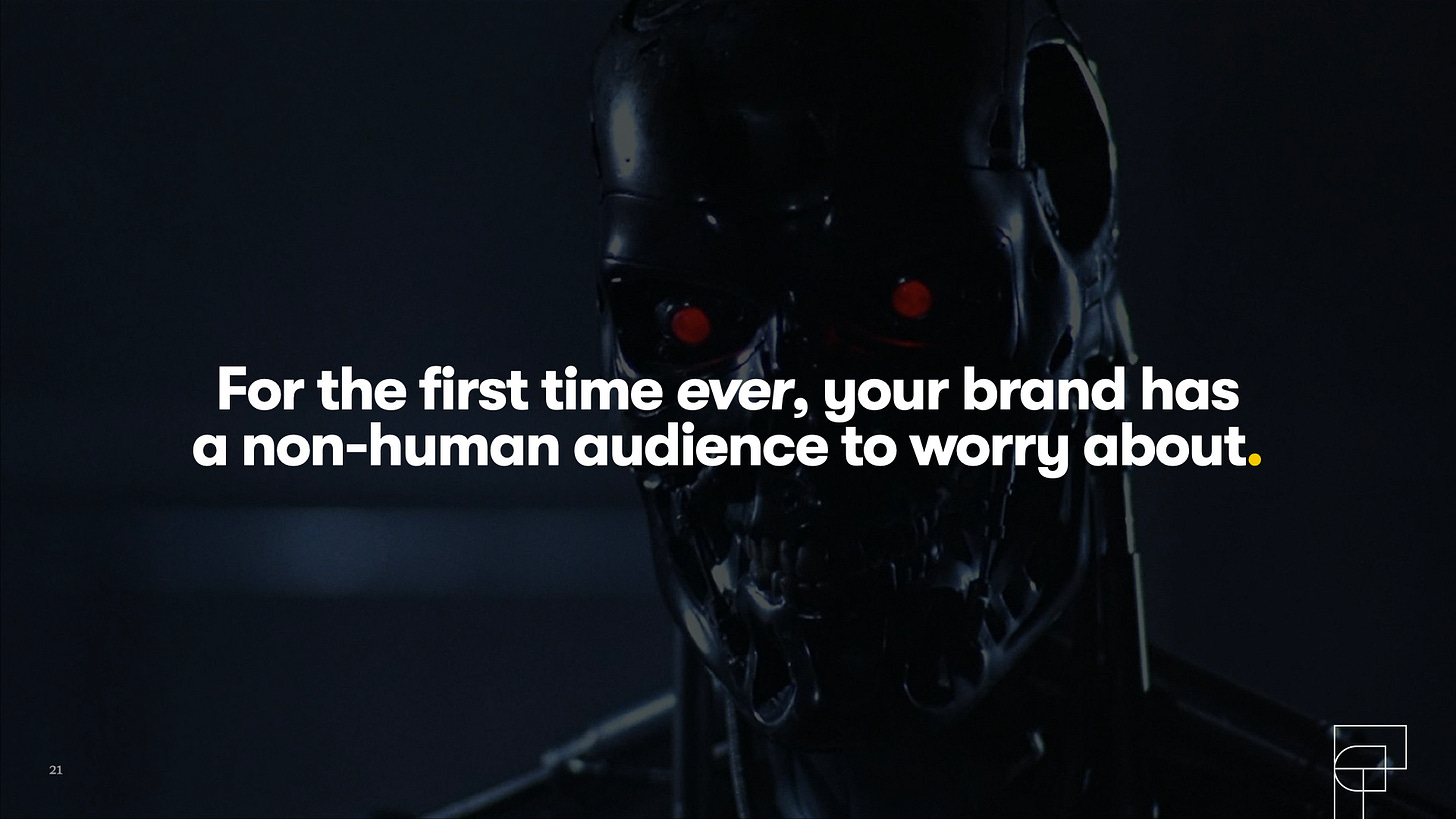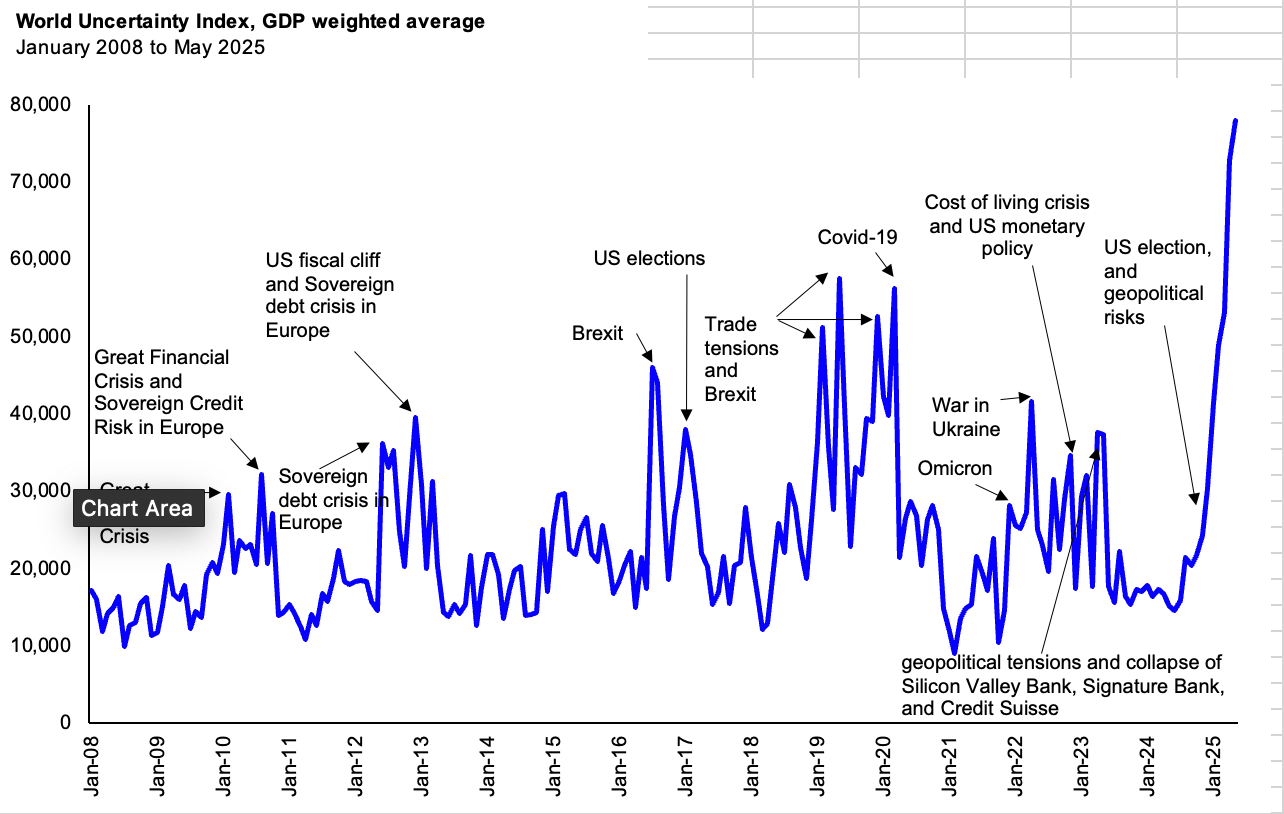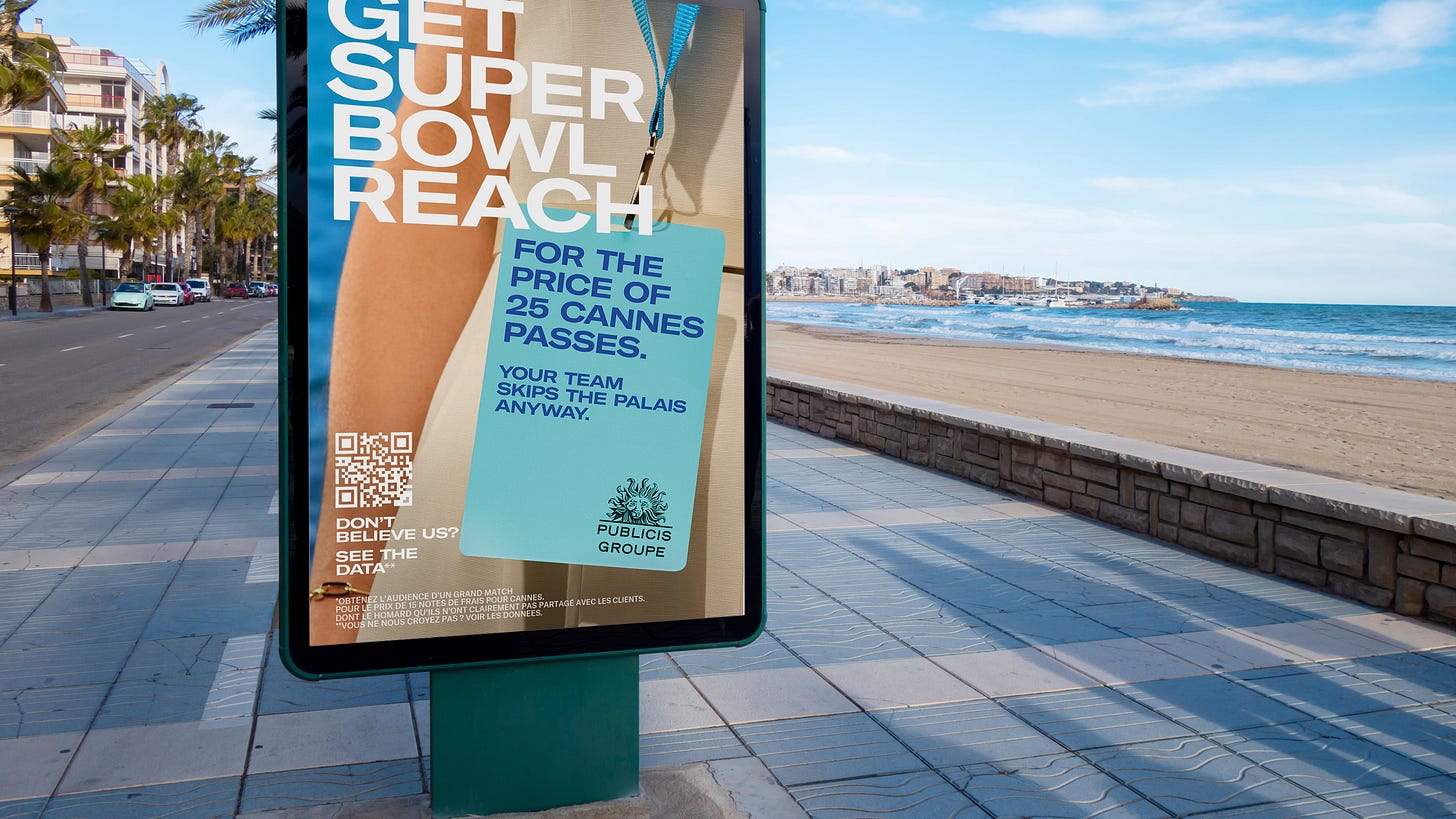You do it to yourself, you do. And that’s what really hurts.
This week:
AI misinfo spreads like an LA wildfire
What will the mood be at Cannes this year?
And maybe we are in the Matrix, as the near future looks like we’ll be targeting bots as much as each other.
The Matthew McConnaughy of Protesting
What Can You Do
The natural outcome of the LA protest is the clear disconnect between the realities on the ground and the narrative being spun by those who want the excuse to push their agenda.
Outright lies posted directly to social media mixed with misinformation spread through established channels by the White House as Donald Trump dramatically escalated federal intervention. The stream of undifferentiated real and fake information has painted a picture of the city that forks from reality.
From the Guardian Misinformation about LA Ice protests swirls online: ‘Catnip for rightwing agitators’
“What’s happening on social media is similar to the chaos of the information environment around the 2020 George Floyd protests. “People are trying to discern between real current footage and recycled sensational old footage repurposed for political or financial ends.”
From CNN Social media algorithms boost L.A. protest misinformation in ‘combustible’ environment
AI to the rescue?
From the Independent Fake videos and AI chatbots drive disinformation about LA protests
While AI-generated videos can be difficult to tell from the real thing, there are ways. They're often suspiciously clean and glossy-looking, as if hailing from the same manicured universe as Kendall Jenner's infamous Pepsi protest advert. The people in them are often strangely beautiful, like the amalgamation of a million magazine photoshoots.
Pretty people of LA - stay home. Don’t F up the AI filter.
From across the pond, the BBC is using its Verify Live to debunk AI fakes as US protests spark online disinformation
Maybe the human touch is still the best.
From LAIst To combat misinformation, start with connection, not correction
1. Consider the terms you use. "[The terms] mis- and disinformation trigger a sort of reaction, and usually distaste,”. instead opt for “rumors” or “misleading content.”
Take time to understand
Talk about your sources and why you consider them trustworthy
Realize you’re not tackling core beliefs, only the sources of information.
Which reminds me, what better way to celebrate presumed Dear Leader’s birthday than to attend a No King’s Day march, which is a national day of action and mass mobilization in response to the increasing authoritarian excesses and corruption of the Trump administration. More than 1,600 events are expected across the US and globe. You can find one nearest you here.

AI is going to give the traditional holding companies their Kodak moment - David Jones, former CEO Havas
A Sober Cannes?
Rosé all day? It feels like the Festival of Creativity, beginning next week, should be a bit more sober than usual, given all of the industry headwinds.
From Business Insider: The exit of ad giant WPP's CEO signals the end of Madison Avenue as we knew it
Madison Avenue is grappling with upheaval as its profit centers shift from creating TV ads with catchy taglines and big branding ideas to trading media, integrating IT systems, and helping clients make sense of their customer data.
"The fundamental challenge is that an enormous amount of what the traditional holding companies do is commodity, and commodity can now be done using technology," said David Jones, the former CEO of the ad agency holding company Havas.
Perhaps this was all foreseen by another Madison Ave icon, David Droga, when he sold his agency to consultancy Accenture. Which has evolved its focus from the creative elements of marketing to a more CRM and customer-data focus.
In the aftermath, the industry has followed along, shifting capabilities and offerings to compete.
Does Droga foresee something again now that he’s stepping out fully as CEO of Accenture Song. As he told Fast Company in February ‘Not all creativity is worth saving’
Look at most advertising. Look at most of the stuff that follows you online. Who wrote this shit? Who’s creating this stuff? Does that need saving? A lot of it’s written by something more alarming than AI, which is research and conformity. And that’s why it’s bland.
Do we need a human for that?
You can get it Fast. Cheap. Or Good. But you can’t get all three.
Has been the mantra of agency feedback forever. But what happens when the client can get Good Enough, Instant and Human Overhead Free?
That’s kind of where we’re headed for a vast majority of what constitutes advertising.
Per the Gartner 2025 CMO Spend Survey:
Marketing budgets have flatlined at 7.7% of overall revenue
Fifty-nine percent of CMOs report they have insufficient budget to execute their strategy in 2025, down by five percentage points since 2024.
Thirty-nine percent of CMOs plan to cut back on agency budgets, including:
eliminating unproductive agency relationships and streamlining agency rosters,
followed by renegotiating agency contracts and scopes of work.
Similarly, thirty-nine percent of CMOs seek to reduce spending on labor, with top cost-saving actions including simplifying overlapping roles and reducing total headcount.
And when they do need a human, that human is likely to be an influencer.
Per The Guardian: Social media creators to overtake traditional media in ad revenue this year
“In 2025, for the first time, more than half of content-driven advertising revenue will come from user-generated platforms and content rather than professionally produced content,”
This comes from a report by WPP Media:
Content creators are expected to see their revenue through ads, brand deals and sponsorships increase by 20% this year.
This figure is expected to more than double to $376.6bn (£278.3bn) by 2030.
Who’s the winner in all of this? (besides Mr Beast). YouTube, has become the ‘central plumbing of the media world’. including podcasts. And is among the five companies that accounted for 54% of all revenues last year – along with Meta, the TikTok owner ByteDance, Amazon, and Chinese e-commerce outlet Alibaba.
Did a Human Even Look At This?
Meanwhile, new studies are questioning whether anyone is watching what we make at all.
Per Hacking the Attention Economy by VCCP and Dr. Karen Nelson-Field
75% of technically viewable ads are served to people who aren’t paying attention
85% of digital ads get less than 2.5 seconds of attention.
Think you’re an outlier here? Think again.
Platform Design Shapes Behavior More Than We Realize
These interfaces are engineered to keep us hooked, constantly tweaked to be harder to resist. The reality of each platform is fixed. It’s this fixed range - or ‘corridor’ - that defines how much attention is even possible. You can work within that corridor, but you can’t break out of it. Essentially, people watch the ads the way the platform trains them to.
Effectively, the attention any ad can earn is capped by the platform’s user experience. You can’t exceed, you can only optimize.
Bringing it all full circle, and back to David Droga’s question:
What Creative is Worth Saving?
The share of what would go to a creative ad agency is shrinking. Taken inside by in-house ‘agencies’. Outsourced to an army of content creators who deliver both production and distribution, and likely much faster. And soon enough, by many of the very platforms themselves as AI can probably handle a lot of the mid-to-lower funnel creation and distribution.
Much of these are self-inflicted wounds. Introduced and championed by an industry that is more interested in account preservation than self preservation. As a consequence, much of what is deemed ‘creative’ is in measurably dull.
It doesn’t erase the need for outside creative thinking, in Droga’s view.
“Now, what’s interesting about that is, that it does not erase the need for incredible things, innovative things. Things that touch you and [allow you to] experience the new. There’s always room for things that are really, really wonderful and delightful. That’s where our role as creators and shapers is always going to be needed and necessary. That’s where my optimism is.”
Just a matter of how many of us are economically viable to keep doing this.
Related:
From WSJ Ad Forecaster Cuts Industry Outlook as Trade Upheaval Risks Five-Year ‘Chilling Effect’
“We expect economic uncertainty is speeding up some AI experimentation with advertisers looking to apply AI-derived production cost savings into more working media,” the report said.
From WSJ News Sites Are Getting Crushed by Google’s New AI Tools
Chatbots are replacing Google searches, eliminating the need to click on blue links and tanking referrals to news sites. As a result, traffic that publishers relied on for years is plummeting.
Maybe, the future of advertising is targeting robots

From Harvard Business Review Forget What You Know About Search. Optimize Your Brand for LLMs.
In a survey of 12,000 consumers, 58% (vs. only 25% in 2023) reported having turned to Gen AI tools for product/service recommendations.
Another study reported a 1,300% surge in AI search referrals to U.S. retail sites during the 2024 holiday season.
NET NET, the new consumer journey may start with a chat as LLMs start to become the first point of entry over websites or even search.
The main takeaway: You must now boost awareness for your brand in LLMs, too.
We’re going to need to figure out how to market to the LLMs, as much as we’re figuring out how to market with them.
From Jon Crowley at
Has some theories as to what this likely means.
Some potentially positive
The attention span problem isn’t a problem anymore… or at least it won’t be for long.
Suddenly, long form is both a way of expressing nuance and depth, but it’s also a way of shaping the machine….What’s interesting is that the long form, with no cuts based on assumptions and with maximum detail for nuance, is going to be way better for an AI audience, and valuable and appreciated for a hyper-engaged audience. The argument against making longer form content (when it makes sense) is probably getting weaker.
Some are a bit more troubling
Explicit Salience - We have to be explicit because we cannot assume any cultural context, nuance, or allusion is going to come through.
LEGO shows up well in animated comedy, in fake desk plants for nerds, in children’s toys, and in pop culture. It all feels different, but all authentically LEGO. What hit me, is this won’t translate to a non-human audience.
Finally, (from Perplexity)
Key Principles for Marketing to LLMs
LLMs prioritize resolution, not attention: Unlike humans, LLMs are not swayed by emotional appeals or flashy branding. They are designed to resolve user queries with accurate, relevant, and trustworthy information.
Visibility is measured by Share of Model (SOM): This new metric assesses how often your brand is mentioned, the gap between human and AI awareness, and the sentiment associated with your brand in LLM outputs.
Content must be structured and context-rich: LLMs draw from a wide range of sources—text, images, videos, reviews, and structured data. They favor content that is well-organized, factual, and directly addresses user needs or queries.
We Choose To Go To the Moon, Not Because It is Easy, But Because It Is Hard
On June 26th in Paris, Nike will welcome fans to Stade Charléty in Paris for the opportunity to support Faith’s moonshot, to become the first woman to break the 4-minute mile. Fans can opt to attend in person or watch online.
How to Watch Breaking4: Faith Kipyegon vs. the 4-Minute Mile
Even if she doesn’t break it, NIKE still wins. Marketers forget, it’s the story we want to follow, not the Cliff Notes version that comes after.
Local Pride
From NY Times This Year’s Pride Festivals Are Brought to You by Small Businesses
Big corporate sponsors are retreating from PRIDE, not renewing their sponsorships and leaving the local festivals short on funds.
If I were a local brewery / retailer etal, I would jump on this and make damn well sure everyone knew who’s shoes I was filling.
Pas Si Vite
From France24 French Senate adopts bill to regulate fast fashion industry in a bid to reduce the environmental impact of the textile industry. Approximately 48 clothing items per person enter the French market annually, with 35 items thrown away every second.
The bill seems particularly directed at Chinese e-commerce sites Temu and Shein, known for selling particularly low quality clothing at low cost.
Important provisions include:
banning advertisements, while imposing sanctions on influencers who promote such products
requiring a consumer-facing ‘eco-score’, informing consumers of the environmental impact of their purchases
imposing a five euro per product penalty for those with the lowest scores
Notably, the bill draws a distinction between ultra fast fashion and traditional fast fashion, providing European brands like Zara and H&M more leniency.

Data is not Neutral
I often say that I see my job as an alternative version of a photographer: I am photographing angles of reality,’ - Federica Fragapane
(from DesignBloom) Italian information designer Federica Fragapane’s ‘Shapes of Inequality’ turns data into art, translating hard, often brutal realities—economic injustice, climate crisis, gender-based violence—into a visual language that is both scientific and sensitive.
Random Quote I’m Pondering
Courage looks like stupidity to an audience of maximizers
Other Stuff:
“Can’t fly on hot dogs and hope,”
T.S.A. is reminding travelers that Costco cards are not on their own going to get you through security. (NY Times)
AI Slop:
How People Are Really Using Gen AI in 2025 (HBR) Last year, it was for ideas. This year, it’s for companionship.
Maybe that’s why everyone panicked this week
ChatGPT outage panic is a stark warning for creatives What to do when your digital muse goes dark? (CreativeBloq)
But those conversations with ChatGPT aren’t as private as you think.
OpenAI slams court order to save all ChatGPT logs, including deleted chats , as part of a lawsuit by news organizations over copyright infringement who are worried about the AI company destroying evidence. (from ArsTechnica)
NET NET assume all AI companies now save everything, regardless of the ‘delete’ option.
Your ChatGPT Logs Are No Longer Private (And Everyone's Freaking Out), but (from The Neuron)
Meanwhile, think of the children (seriously this time)
A new line of addiction is in the pipeline for kids: chatbot addiction
Ocean acidification crosses “planetary boundaries” (Ars Technica) 5 YEARS AGO!!! Also in 2023, researchers determined that six of these boundaries had already been crossed. The new research adds A WORRYING SEVENTH.
Real reasons people do not have the number of children they want revealed in new report (The Guardian). While right-wing governments blame this on a rejection of parenthood, the reality is that many want children, but a number of factors, including the cost of living, are preventing them.
Research without lab animals? Increasingly, AI, mini lungs on a chip, and more are replacing animals in biology research (from ScienceNewsExplores)
AI Slop
Other Entertainment:
Martin Scorsese no longer watches films in cinemas due to audience bad behaviour (from The Guardian)
Did American movies help propel Trump back to the White House? (The Contrarian) When’s the last time you ever saw government depicted as competent or decent? The ‘Hollywood-default’ is anyone from government is not to be trusted.
The idea behind Gaza Sound Man is to capture the raw power of sound as a vessel for storytelling
Gaza Sound Man is available to view now
Wu-Tang Clan ain’t nothing to f- with…but you can play with them.
Wu-Tang Clan’s new video game project is ‘for the culture’ (from Wired)
Ever Wondered How Many Hands Touch Your Food at a Restaurant Before It Gets to You? (from Food and Wine)
Feeling sorry for yourself. Scientists create 'world's smallest violin' (from BBC)
Resourceful:
From Julia’s Bicycle, a non-profit mobilising the arts and culture to take action on the climate crisis, comes The Creative Freelancers Climate Almanac, a companion for artists, independent creatives, community practitioners and producers engaging in climate action.
Say something once, why say it again?
Absolute Best… Pride campaigns (Marketing Beat)
How e.l.f. and Microsoft turned a viral sailing voyage into a brand moment (Ad Age)
Resourceful:
State of the Consumer 2025: When disruption becomes permanent (from McKinsey)




















